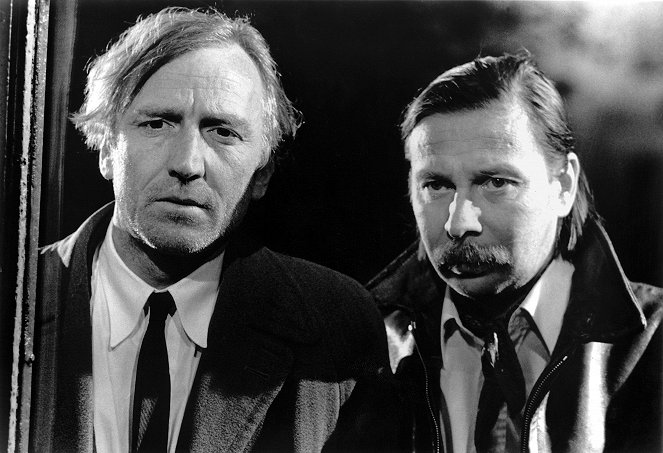Réalisation:
Aki KaurismäkiScénario:
Aki KaurismäkiPhotographie:
Timo SalminenActeurs·trices:
Matti Pellonpää, Evelyne Didi, André Wilms, Kari Väänänen, Christine Murillo, Jean-Pierre Léaud, Carlos Salgado, Alexis Nitzer (plus)Résumés(1)
Auteur en mal d'éditeur, Marcel Marx (André Wilms) est expulsé de chez lui. Il rencontre un peintre albanais, lui aussi sans-le-sou, Rodolfo (Matti Pellonpää), puis Schaunard (Kari Väänänen), un compositeur irlandais. Les trois hommes deviennent bientôt inséparables et décident de partager leur misère et leur passion pour les arts... D'après le roman d'Henry Murger. (Pyramide Distribution)
(plus)Critiques (5)
Est-ce que l' "Carré noir sur fond blanc" de Malevitch a porté un coup fatal à la peinture en tant que telle ? Et que l'artiste Rodolfo l'admet ? Et malgré cela, il continue encore à peindre ? Cela s'appelle l'amour de la création en tant que tel, un amour que tous les principaux protagonistes ont plus qu'assez, mais cela ne signifie pas qu'il n'y a plus de place pour l'amour humain. De la vie hors du temps, ils ne peuvent être arrachés que lorsque le monde extérieur se fait entendre, sous forme d'argent, dont (malheureusement) même les artistes doivent tirer leur subsistance. Un regard drôle, mélancolique, et, finalement, amer-doux sur la vie de trois hommes qui pourraient avoir vécu il y a 150 ans ou hier.
()
Proud but painful misery. Compassion and vanity. A beautiful rhapsody about poor "artists" whose greatest art is life itself - polite, unconditional, ceremonial in every bar. This is probably Kaurismäki's most tragic film (if we set aside last year's Le Havre) and also one of his directorial highlights.
()
My first encounter with Aki Kaurismäki and right off the bat, one of his most difficult movies. It was amazing to watch the emotions and actions of those French bohemians. One might think that they’re nuts. So what, they really are nuts. Eventually, fate catches up with them and at that point, it doesn’t even matter how careless they are about the world around them. I must also applaud the amazing black-and-white atmosphere of the Parisian streets. It was a joy to watch them and it helped shape the atmosphere a lot… obviously.
()
I like Kaurismäki's melancholic comedies set in an urban environment and shot in black and white. However, Aki's penchant for melodramatic tragedy with increasingly swelling sentiment is a big problem for me. In The Bohemian Life, you can find both - I value the first half more, where the comedic elements are more prevalent. The second half wants to be moving. I must note that I have always had a distant attitude towards bohemians. I considered them pleasure-seeking and hypocritical. No matter how alternative they appeared, they were dependent on the bourgeois surroundings that sustained and protected them. The film can be regarded as a tribute to the artistic environment of which Kaurismäki was a part. And it is also an expression of respect for his partner, Paula Oinonen, who is the author of the paintings by the painter Rodolf. For me, the director's work with the environment is probably the most interesting aspect. His selection of interiors and exteriors allows for creating an illusion of timelessness and connecting 19th-century Paris with the modern era. For a moment, you feel like you are walking the streets of the 1930s with the typical characters of the Parisian outskirts and then suddenly stop on the sidewalk next to a modern car. Overall impression: 75%.
()
The main reason I like Aki Kaurismäki's film is that the visuals he used are a perfect match for the story presented. Black and white cinematography doesn't suit every film nowadays, but if an author decides to use it, they usually have a good reason for it. Aki Kaurismäki knew this and it makes the film nice to watch. Plot-wise, it may not necessarily be captivating.
()


Annonces